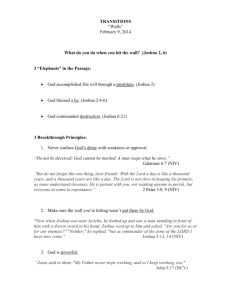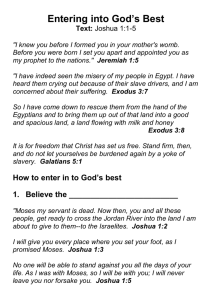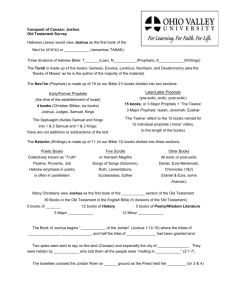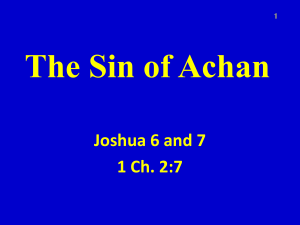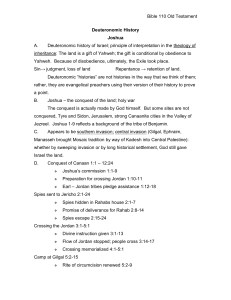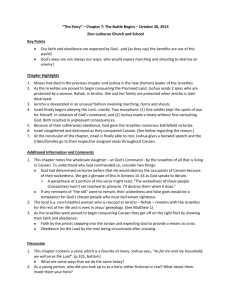History, Archaeology and the Bible 2.17 Mb
advertisement
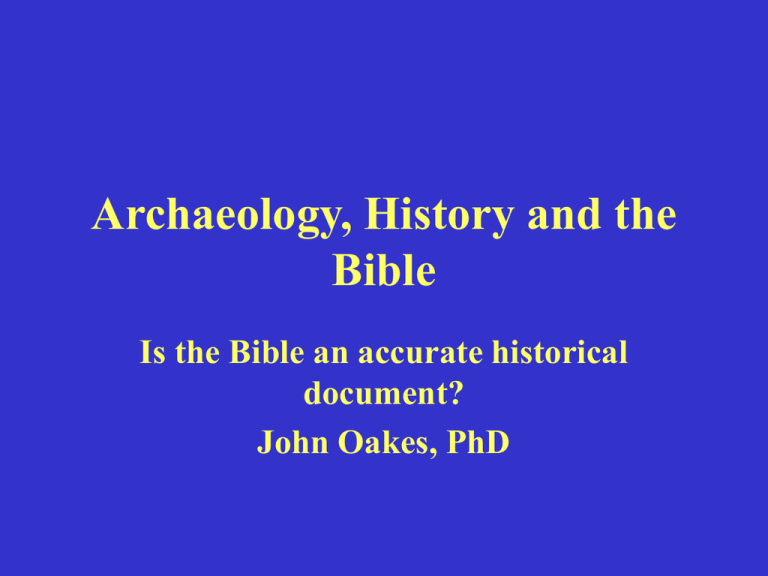
Archaeology, History and the Bible Is the Bible an accurate historical document? John Oakes, PhD IMPORTANT PERIODS IN THE HISTORY OF ISRAEL Period in the History of Israel Dates The Patriarchs Abraham, Isaac, Jacob and Joseph 2050-1800 BC Moses and Joshua The Exodus and the Conquest 1450-1400 BC The Period of the Judges Deborah, Jephthah, Gideon and Samuel 1400-1050 BC The United Kingdom Saul, David, Solomon and Rehoboam 1050-931 BC The Northern Kingdom (Samaria) Destruction and captivity under Assyria 931-722 BC The Southern Kingdom (Judah) Destruction and captivity under Babylon 931-586 BC Defeat and destruction of Jerusalem The period of the exile in Babylon 605-536 BC Return of the captives, rebuilding of the temple and of Jerusalem 536-440 BC The period “between the Testaments” 440-6 BC DOMINANT POWERS DURING THE HISTORY OF ISRAEL Dominant Power Dates Hittites and Egyptians 2000-900 BC Assyria 900-606 BC Babylon 605-539 BC Persia 538-331 BC Alexander and the Greek Dynasties 330-63 BC Rome After 63 BC Ziggurat in Ur Haran Ruins In Mesopotamian Plane Near Sanli Urfa, Turkey One of the Ebla Tablets about 2100 BC The Five City League, including Sodom and Gomorrah Ruins of Hattusha, capital of the Hittites The Lion Gate in Hattusha Beni-Hasan Egyptian Tomb Painting Papyrus Ipuwer • 2:2—The river is blood = The river was turned to blood—Exod 7:20 • 2:6— Blood is everywhere = Blood is throughout all the land of Egypt— Exod 7:21 • 4:14—Trees are destroyed = And the hail… broke every tree in the field— Exod 9:25 • 9:11—The land is not light = And Moses stretched forth his hand… and there was a thick darkness— Exod 10:22 • 2:13—He who places his brother in the ground is everywhere = For there was not a house where there was not someone dead— Exod 12:30 One of the Tel El Amarna Letters 1400 BC Archaeological Facts about Jericho 1. The city was strongly fortified in the Late Bronze I period, the time of the Conquest according to the biblical chronology (Joshua 2:5,7,15). 2. The city was massively destroyed by fire (Joshua 6:24). 3. The fortification walls collapsed at the time the city was destroyed, possibly by earthquake activity (Joshua 6:20). 4. The destruction occurred at harvest time, in the spring, as indicated by the large quantities of grain stored in the city (Joshua 2:6, 3:15, 5:10). 5. The siege of Jericho was short, as the grain stored in the city was not consumed (Joshua 6:15,20). 6. Contrary to what was customary, the grain was not plundered, in accordance to the command given to Joshua (Joshua 6:17,18). The Stele of Merneptah Egypt, 1230 BC Mentions the Israelites in Canaan The Moabite Stone or Mesha Stele 870 BC the Louvre Ahab “of the house of Omri” 1 Kings 16:28 Black Obelisk of Shalmanezer III 840 BC British Museum 2 Kings 17:3-6 The Tel Dan Inscription 820 BC 2 Kings 8:28-29 ‘I killed Jehoram, son of Ahab, king of Israel and I killed Ahaziah, son of Jehoram, king of the house of David” The Sennacherib Cylinder or Taylor Prism British Museum, London (2 Kings 18) 691 BC As to Hexekian the Jew… I made him… “like a bird in a cage” The Babylonian Chronicles British Museum, London, 597 BC 2 Kings 24:10-17 One of the Lachish Letters, 586 BC Jeremiah 34:6,7 Cyrus Cylinder British Museum 535 BC Ezra 1:2-4 Ziggurat in Ur Pilate Inscription Cesarea Maritima AD 30 Discovered 1961 Tiberius, Pontius Pilatus, Prefect of Judea Sir William Ramsay I found myself brought into contact with the Book of Acts as an authority for the topography, antiquities, and society of Asia Minor. It was gradually borne upon me that in various details the narrative showed marvelous truth. In fact, beginning with a fixed idea that the work was essentially a second century composition, and never relying on its evidence as trustworthy for first century conditions, I gradually came to find it a useful ally in some obscure and difficult investigations. Luke is a historian of the first rank; not merely are his statements of fact trustworthy; he is possessed of the true historic sense; he fixes his mind on the idea and plan that rules in the evolution of history, and proportions the scale of his treatment to the importance of each incident. He seizes the important and critical events and shows their true nature at greater length, while he touches lightly or omits entirely much that was valueless for his purpose. In short, this author should be placed along with the very greatest of historians. Sir William Ramsay, St. Paul, the Traveler and the Roman Citizen, (Hodder and Stoughton, 1920). Archaeological Evidence The Pool of Siloam Caiaphas Ossuary

